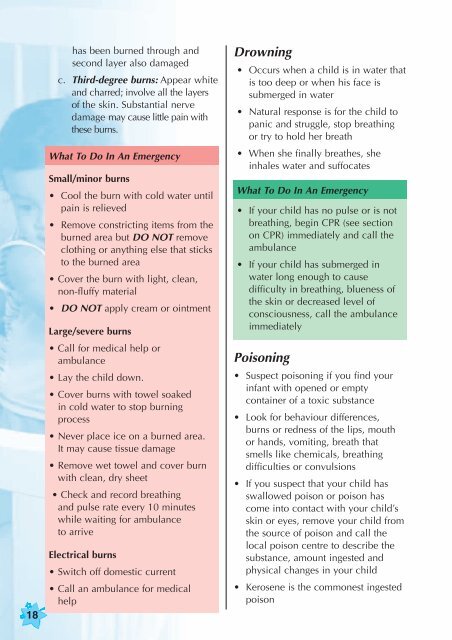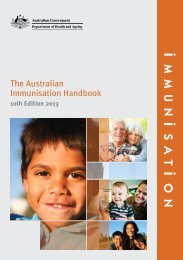English - pdf - 1234 Kb - Malaysian Paediatric Association
English - pdf - 1234 Kb - Malaysian Paediatric Association
English - pdf - 1234 Kb - Malaysian Paediatric Association
Create successful ePaper yourself
Turn your PDF publications into a flip-book with our unique Google optimized e-Paper software.
18<br />
has been burned through and<br />
second layer also damaged<br />
c. Third-degree burns: Appear white<br />
and charred; involve all the layers<br />
of the skin. Substantial nerve<br />
damage may cause little pain with<br />
these burns.<br />
What To Do In An Emergency<br />
Small/minor burns<br />
• Cool the burn with cold water until<br />
pain is relieved<br />
• Remove constricting items from the<br />
burned area but DO NOT remove<br />
clothing or anything else that sticks<br />
to the burned area<br />
• Cover the burn with light, clean,<br />
non-fluffy material<br />
• DO NOT apply cream or ointment<br />
Large/severe burns<br />
• Call for medical help or<br />
ambulance<br />
• Lay the child down.<br />
• Cover burns with towel soaked<br />
in cold water to stop burning<br />
process<br />
• Never place ice on a burned area.<br />
It may cause tissue damage<br />
• Remove wet towel and cover burn<br />
with clean, dry sheet<br />
• Check and record breathing<br />
and pulse rate every 10 minutes<br />
while waiting for ambulance<br />
to arrive<br />
Electrical burns<br />
• Switch off domestic current<br />
• Call an ambulance for medical<br />
help<br />
Drowning<br />
• Occurs when a child is in water that<br />
is too deep or when his face is<br />
submerged in water<br />
• Natural response is for the child to<br />
panic and struggle, stop breathing<br />
or try to hold her breath<br />
• When she finally breathes, she<br />
inhales water and suffocates<br />
What To Do In An Emergency<br />
• If your child has no pulse or is not<br />
breathing, begin CPR (see section<br />
on CPR) immediately and call the<br />
ambulance<br />
• If your child has submerged in<br />
water long enough to cause<br />
difficulty in breathing, blueness of<br />
the skin or decreased level of<br />
consciousness, call the ambulance<br />
immediately<br />
Poisoning<br />
• Suspect poisoning if you find your<br />
infant with opened or empty<br />
container of a toxic substance<br />
• Look for behaviour differences,<br />
burns or redness of the lips, mouth<br />
or hands, vomiting, breath that<br />
smells like chemicals, breathing<br />
difficulties or convulsions<br />
• If you suspect that your child has<br />
swallowed poison or poison has<br />
come into contact with your child’s<br />
skin or eyes, remove your child from<br />
the source of poison and call the<br />
local poison centre to describe the<br />
substance, amount ingested and<br />
physical changes in your child<br />
• Kerosene is the commonest ingested<br />
poison
















